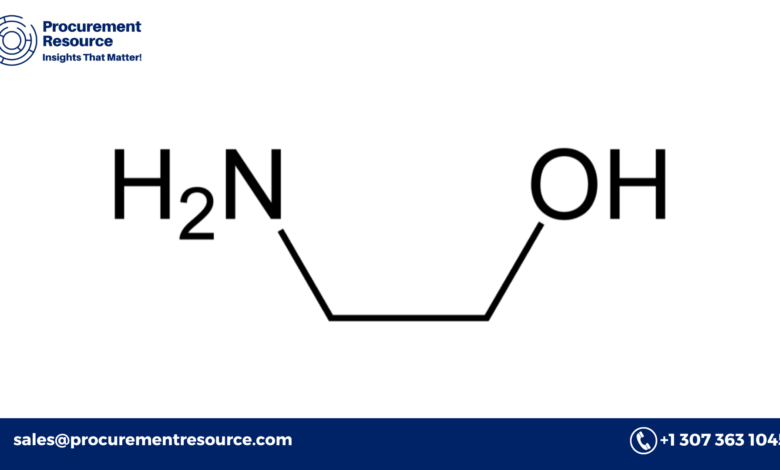
Acetaldehyde is an important organic compound used as an intermediate in the manufacture of various chemicals, including acetic acid, perfumes, and flavorings. It also plays a role in the production of ethanol, plastics, synthetic rubber, and many other products. The acetaldehyde production cost analysis is influenced by several factors, such as raw material costs, energy consumption, production methods, labor, and environmental regulations.
This article provides a detailed analysis of the factors influencing the production cost of acetaldehyde, historical trends in production costs, and future projections for its production in the global market.
Table of Contents
ToggleFactors Influencing Acetaldehyde Production Costs
1. Raw Material Costs
Acetaldehyde is produced from a variety of raw materials, including ethanol, ethylene, and acetic acid. The choice of raw material largely depends on the production method, market conditions, and availability of feedstock. The cost of these raw materials has a significant impact on the overall cost of acetaldehyde production.
Ethanol
One common method of acetaldehyde production involves the dehydrogenation of ethanol. Ethanol is produced from either petrochemical sources or biological fermentation. The price of ethanol is influenced by the availability of feedstocks like sugarcane or corn, as well as global fuel ethanol demand. Volatility in ethanol prices, driven by factors such as crop yields, global ethanol policies, or biofuel mandates, can directly affect the production cost of acetaldehyde.
Request For Free Sample: https://www.procurementresource.com/production-cost-report-store/acetaldehyde/request-sample
Ethylene
Another common method involves oxidation of ethylene using air or oxygen in the presence of a catalyst. Ethylene is derived from crude oil or natural gas through steam cracking, and its price is closely linked to crude oil prices. Fluctuations in global oil prices and the supply-demand balance for ethylene have a significant impact on acetaldehyde production costs. Any disruptions in crude oil supply, price spikes, or changes in ethylene availability directly influence the cost of producing acetaldehyde.
Acetic Acid
In some methods, acetic acid is hydrogenated to produce acetaldehyde. Acetic acid itself is produced either from methanol or as a by-product of certain fermentation processes. The cost of acetic acid is linked to the price of methanol, which, like ethylene, is dependent on natural gas or crude oil prices. Changes in methanol prices or acetic acid production methods can significantly impact the cost of producing acetaldehyde.
2. Production Methods and Technology
There are several methods to produce acetaldehyde, each with different costs and efficiencies. The choice of production method depends on factors such as raw material availability, desired production scale, and market demand.
1. Dehydrogenation of Ethanol
The dehydrogenation process involves heating ethanol in the presence of a catalyst to produce acetaldehyde and hydrogen as a by-product. This method is commonly used in regions where ethanol is inexpensive or easily available. However, the high cost of ethanol can make this process less economically viable compared to other methods.
2. Oxidation of Ethylene
The oxidation of ethylene is a more common and cost-effective method for large-scale production of acetaldehyde. In this process, ethylene reacts with oxygen in the presence of a metal oxide catalyst to produce acetaldehyde. This method has lower energy requirements compared to ethanol dehydrogenation, and it offers higher yields. However, it is dependent on the availability of ethylene, and its cost is closely linked to fluctuations in crude oil prices.
3. Wacker Process
The Wacker process involves the oxidation of ethylene using a palladium chloride catalyst, yielding acetaldehyde. This method is often chosen for high-yield production and involves sophisticated catalytic reactions. The cost of palladium, a precious metal, can add significantly to the production cost, especially during periods of high metal prices.
By-Product Management
By-products like hydrogen, carbon dioxide, or other impurities are produced during the synthesis of acetaldehyde. Managing these by-products involves additional costs, especially if the by-products need to be treated to meet environmental standards. Some by-products can be utilized for value-added purposes, such as using hydrogen for energy, which can help offset production costs.
3. Energy Consumption
Acetaldehyde production is energy-intensive, particularly during processes such as ethanol dehydrogenation or ethylene oxidation. Energy costs, especially for heating, cooling, and distillation, make up a significant portion of the overall production cost.
Heating and Cooling Requirements
The production processes involve both heating (to drive reactions) and cooling (to separate and purify acetaldehyde). The amount of energy required depends on the production scale, reactor design, and operating conditions. Rising energy prices, especially for natural gas or electricity, can lead to increased production costs.
Electricity and Fuel Costs
Electricity is needed to power machinery, pumps, and control systems throughout the production process. Any increases in electricity or fuel prices directly affect the production cost of acetaldehyde. Producers in regions with access to cheap electricity, such as hydroelectric power, often have a cost advantage.
Energy Efficiency Improvements
Improving energy efficiency is a key focus for acetaldehyde producers. Investing in better reactor designs, heat exchangers, and process optimization can help reduce energy consumption and lower production costs. However, these improvements typically require significant upfront capital investments.
4. Labor Costs
Labor costs are another significant factor in the overall production cost of acetaldehyde. These costs vary based on the region, level of automation in the production facility, and the availability of skilled labor.
Skilled Labor for Chemical Production
Producing acetaldehyde requires skilled workers to operate reactors, monitor process conditions, and manage quality control. Labor costs are higher in regions with high wage rates or labor shortages. Automation can help reduce labor requirements, but it involves a substantial initial investment.
Workforce Efficiency
Improving workforce efficiency through training, process automation, and better production management can help reduce labor costs. In regions with low labor costs, producers may prefer labor-intensive processes, while those in high-cost regions invest in automation to improve efficiency.
5. Environmental Regulations and Compliance Costs
Acetaldehyde production involves the use of chemicals and processes that can pose environmental risks. Compliance with environmental regulations is a key consideration for acetaldehyde producers, as non-compliance can lead to penalties, increased costs, or operational disruptions.
Emissions and Effluent Control
The production of acetaldehyde can generate emissions of volatile organic compounds (VOCs), carbon dioxide, and other gases that must be controlled. Compliance with air quality standards involves investing in emissions control equipment, such as scrubbers or catalytic converters, to minimize environmental impact. Wastewater treatment and proper disposal of effluents are also required to comply with environmental standards, adding to production costs.
Regulatory Compliance Costs
Environmental compliance also involves regular inspections, certifications, and ongoing audits. Compliance with chemical safety regulations, such as REACH (Registration, Evaluation, Authorization, and Restriction of Chemicals) in Europe, requires investment in safe storage, handling, and documentation of chemicals used in acetaldehyde production. These costs contribute to the overall production expenses.
6. Packaging, Transportation, and Logistics
After production, acetaldehyde must be stored, packaged, and transported to end users. The cost of packaging and logistics adds to the overall production cost.
Packaging Requirements
Acetaldehyde is a volatile and flammable liquid that requires specialized packaging to ensure safety during storage and transportation. The use of specialized containers, such as drums or bulk tanks, adds to the cost of production. Packaging materials must also meet safety standards to prevent leaks or damage during transit.
Transportation and Shipping Costs
The cost of transporting acetaldehyde to customers depends on factors such as distance, transportation mode, and regional regulations. Acetaldehyde is classified as a hazardous material, and its transportation requires special handling, which adds to logistics costs. Rising fuel prices and disruptions in the shipping industry can further increase transportation expenses.
Historical Trends in Acetaldehyde Production Costs
1. Pre-2010 Period: Stable Production Costs
Before 2010, the production cost of acetaldehyde was relatively stable, with moderate fluctuations due to changes in raw material prices and energy costs. The most common production methods, such as ethylene oxidation, were well-established, and energy prices were relatively stable, contributing to predictable production costs.
2. 2010-2015: Rising Energy and Raw Material Costs
Between 2010 and 2015, production costs for acetaldehyde began to rise due to increasing prices of raw materials such as ethylene and ethanol. The volatility in crude oil prices also affected the cost of ethylene, leading to higher production costs. Environmental regulations became more stringent during this period, requiring manufacturers to invest in emissions control technologies, which further increased production costs.
3. 2016-2020: Focus on Efficiency and Environmental Compliance
From 2016 to 2020, manufacturers invested in energy-efficient technologies and process optimizations to reduce production costs. However, the need to comply with stricter environmental regulations, particularly in Europe and North America, led to increased costs for emissions control and waste management. Despite improvements in efficiency, the rising costs of compliance and raw materials kept overall production expenses elevated.
4. 2020-2021: COVID-19 Pandemic Impact
The COVID-19 pandemic in 2020 led to disruptions in global supply chains, affecting the availability of raw materials like ethanol and ethylene. Production costs increased due to labor shortages, factory shutdowns, and logistical bottlenecks. As demand recovered in late 2020 and 2021, raw material prices surged, putting additional pressure on production costs.
5. 2022-2023: Geopolitical Tensions and Rising Energy Prices
In 2022 and 2023, the cost of producing acetaldehyde surged due to rising energy prices and geopolitical tensions, particularly the Russia-Ukraine conflict. The increased cost of natural gas and crude oil, which are key inputs for ethylene production, drove up raw material costs. Additionally, transportation costs increased due to higher fuel prices and global shipping disruptions.
Future Projections for Acetaldehyde Production Costs
1. Short-Term Outlook
In the short term, acetaldehyde production costs are expected to remain elevated due to continued volatility in raw material and energy markets. The ongoing energy crisis, particularly in Europe, will likely keep production costs high, as manufacturers struggle with increased energy expenses and raw material supply constraints.
2. Long-Term Outlook
In the long term, improvements in production efficiency and a shift toward more sustainable methods of chemical production may help reduce costs. The growing emphasis on sustainability and recycling in the chemical industry could lead to investments in new production technologies, such as bio-based routes for acetaldehyde production. However, these innovations will require significant capital investments, which may take time to translate into reduced production costs.
The focus on renewable energy sources and the adoption of cleaner technologies are expected to play a critical role in lowering energy consumption and emissions, potentially stabilizing production costs.
Contact Us:
Company Name: Procurement Resource
Contact Person: Leo Frank
Email: sales@procurementresource.com
Toll-Free Number: USA & Canada — Phone no: +1 307 363 1045 | UK — Phone no: +44 7537 132103 | Asia-Pacific (APAC) — Phone no: +91 1203185500
Address: 30 North Gould Street, Sheridan, WY 82801, USA



